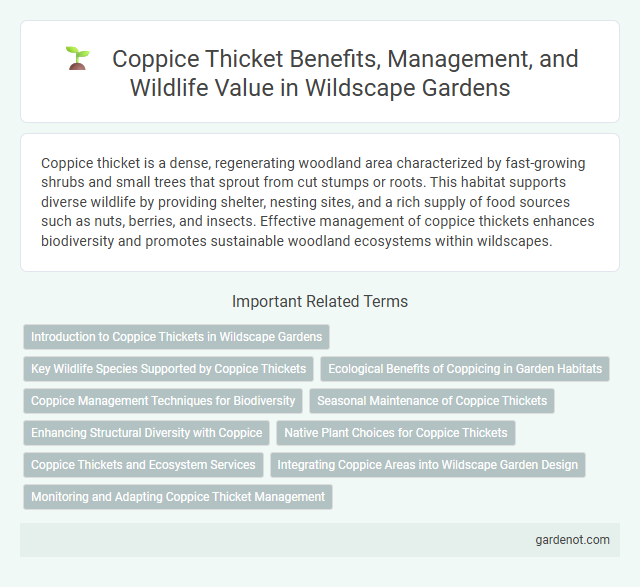Coppice thicket is a dense, regenerating woodland area characterized by fast-growing shrubs and small trees that sprout from cut stumps or roots. This habitat supports diverse wildlife by providing shelter, nesting sites, and a rich supply of food sources such as nuts, berries, and insects. Effective management of coppice thickets enhances biodiversity and promotes sustainable woodland ecosystems within wildscapes.
Introduction to Coppice Thickets in Wildscape Gardens
Coppice thickets in Wildscape Gardens are dense clusters of young, regenerating trees managed through traditional coppicing techniques to promote biodiversity and habitat variety. These thickets provide crucial shelter and food sources for wildlife such as birds, small mammals, and invertebrates, supporting ecosystem health. Managed coppice cycles enhance woodland structure, encouraging growth stages that benefit species diversity within Wildscape's conservation strategy.
Key Wildlife Species Supported by Coppice Thickets
Coppice thickets provide essential habitat for key wildlife species such as the Eurasian jay, nightingale, and hazel dormouse, which rely on dense, regenerating woodlands for nesting and foraging. These thickets support a rich invertebrate community, including butterflies like the silver-washed fritillary and moth species that depend on early successional plants. Through their structural diversity, coppice thickets enhance biodiversity by offering shelter, food resources, and breeding sites critical for sustaining wild populations.
Ecological Benefits of Coppicing in Garden Habitats
Coppice thickets play a crucial role in enhancing biodiversity by providing dense shelter and nesting sites for various wildlife species, including birds, insects, and small mammals. The cyclical cutting and regrowth of vegetation in coppicing promotes diverse plant structures and light conditions, which support a wide range of flora and fauna. This sustainable woodland management technique improves soil health, increases carbon sequestration, and helps maintain balanced garden ecosystem dynamics.
Coppice Management Techniques for Biodiversity
Coppice management techniques involve periodic cutting of woody vegetation to stimulate regrowth, creating a dynamic habitat mosaic that supports diverse flora and fauna in wildscape environments. Implementing rotational coppicing promotes structural diversity, enhances light penetration, and fosters understorey plant species critical for invertebrates, birds, and mammals. Maintaining a varied coppice age structure is essential for sustaining high biodiversity levels and ecological resilience within managed thickets.
Seasonal Maintenance of Coppice Thickets
Seasonal maintenance of coppice thickets involves strategic cutting and clearing during late winter to promote healthy regrowth and biodiversity within the wildscape. Regular removal of old wood enhances light penetration, encouraging a rich understory and supporting diverse wildlife habitats. This cyclical management ensures the vitality of the coppice thicket ecosystem, maintaining its structural complexity and ecological balance.
Enhancing Structural Diversity with Coppice
Coppice thickets play a vital role in enhancing structural diversity within wildscapes by promoting multi-stemmed growth and dense underbrush, which provides critical habitat for diverse wildlife species. Regular coppicing cycles stimulate vigorous regrowth, increasing light penetration and creating varied vertical layers that support insects, birds, and small mammals. This dynamic habitat structure improves ecological resilience while maintaining biodiversity through continuous habitat renewal and complexity.
Native Plant Choices for Coppice Thickets
Native plant choices for coppice thickets in wildscapes emphasize species like hazel (Corylus avellana), hawthorn (Crataegus monogyna), and dogwood (Cornus sanguinea) due to their robust regrowth after cutting. These plants enhance biodiversity by providing essential habitats and food sources for pollinators, birds, and small mammals. Selecting fast-growing, native shrubs with strong regenerative capacity supports sustainable thicket management and ecological balance.
Coppice Thickets and Ecosystem Services
Coppice thickets play a vital role in maintaining biodiversity by providing habitat and food sources for various wildlife species, including birds and insects. These dense, regenerating growths contribute to soil stabilization and improve water retention, enhancing overall ecosystem resilience. Sustainable coppicing supports carbon sequestration, making coppice thickets essential for climate regulation and ecological balance within wildscape environments.
Integrating Coppice Areas into Wildscape Garden Design
Integrating coppice areas into Wildscape garden design enhances biodiversity by providing essential habitats for native wildlife such as birds, insects, and small mammals. Implementing rotational coppicing promotes sustainable growth and maintains dense underbrush, which supports diverse plant species and improves soil health. Strategic placement of coppice thickets creates natural corridors that connect habitats, fostering ecological balance and enriching the overall garden ecosystem.
Monitoring and Adapting Coppice Thicket Management
Monitoring coppice thickets involves regular assessment of tree regrowth, biodiversity levels, and soil health to ensure sustainable habitat conditions for wildlife in Wildscape areas. Adaptive management techniques such as selective cutting and rotational coppicing optimize growth cycles, maintain structural diversity, and promote ecosystem resilience. Data-driven adjustments based on periodic surveys support long-term conservation goals by balancing ecological restoration with habitat complexity.
Coppice thicket Infographic

 gardenot.com
gardenot.com